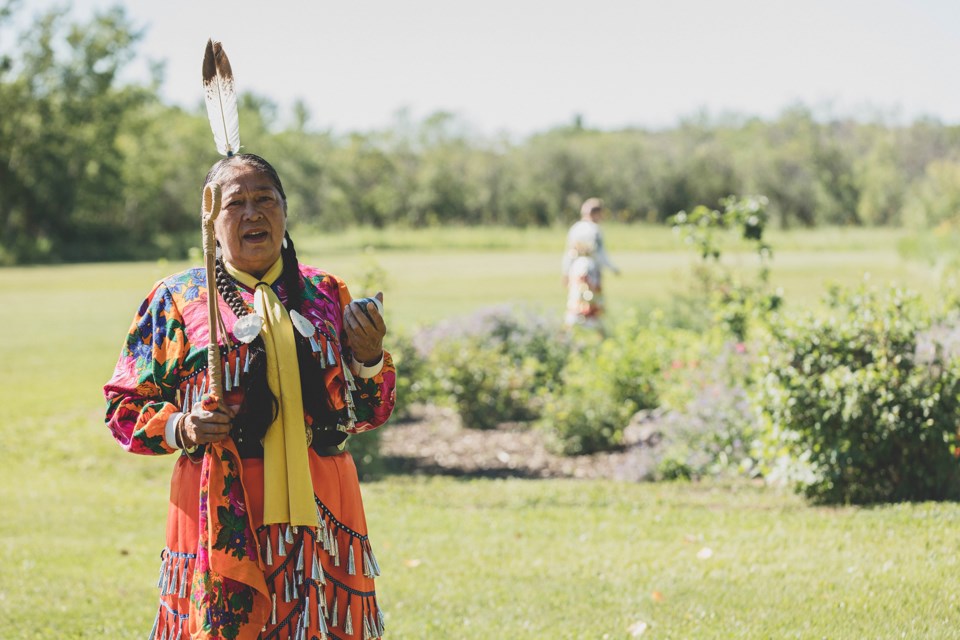ST. PAUL, Alta. - A ground search for unmarked graves at a former residential school located just a few miles west of St. Paul officially started last Tuesday, following a morning steeped in ceremony.
The site, which now houses University nuhelot’įne thaiyots’į nistameyimâkanak Blue Quills (UnBQ), still includes the large brick building that was in operation as a residential school from 1931 to about 1970. Throughout the week, wellness supports and ceremony were offered to those in attendance, many of whom were residential school survivors.
On Aug. 11, a full moon walk was also held, and on Aug. 9 a healing jingle dress dance made its way around the healing garden located in front of the building that once was a residential school. The area was also the primary focus of the ground search team from the University of Alberta that was on site throughout the week.
Ceremony was at the forefront of the entire week, and included the five-member ground penetrating radar team - and even their equipment. Each morning the machines and equipment were smudged before and after the processes took place, according to Terri Cardinal, IRS Project Coordinator.
"I’m thankful for the kindness and compassion everyone has for one another here," she said.
Kisha Supernant, director with the Institute of Prairie and Indigenous Archaeology at the University of Alberta, was on site Aug. 9, leading the ground penetrating radar team in its first day of what she described as phase one of the process of "searching for the missing children."
"We'll spend most of the time pushing the ground penetrating radar over every inch of the ground, and it sends a signal down into the ground that shows us changed in the soil below, so if there's say a rock buried, we'll be able to see that... and potentially if there's a burial," explained Supernant.
"So we want to cover every possible part of the grid that we layout, to make sure that we're not missing anything," she added.
The first area of focus of the ground penetrating search is the front area of the yard at UnBQ.
"There are a few reasons for that. One is because it is an area that they want to do some building on... also, there is knowledge from the community of potential graves. It's also open, flat, it's mowed. The ground penetrating radar needs to be on the ground's surface."
The team was also aware that there were other areas of the school's grounds of concern. Part of the process of last week's phase one of the search was to gather more of that information.
"Members come, and survivors come, and they often share with us other places that they're concerned about. And then we can help advise the people who make decisions about what happens in terms of what their next steps might be," explains Supernant.
Results from the ground penetrating radar will not be known for several months.
The search at UnBQ was the eighth school the U of A team has been involved with since the news came out in 2021 regarding 215 unmarked graves being discovered at a former residential school in Kamloops, although Supernant says she's been involved in work around grave sites at former residential schools and other areas.
"So there's eight schools, but there's more on the horizon. We've talked with over 40 Nations."
Supernant also sits on the National Advisory Committee on Residential Schools Missing Children and Unmarked Burials. The group was announced by the federal government on July 20, 2022, Minister of Crown-Indigenous Relations Marc Miller, and Stephanie Scott, the Executive Director of the National Centre for Truth and Reconciliation (NCTR).
Establishing the National Advisory Committee on Residential Schools Missing Children and Unmarked Burials responds to the Truth and Reconciliation Commission's Calls to Actions #74 to 76 on residential schools Missing Children and Burial Information, according to the federal government.
The work being done at the UnBQ site is separate from work that is being done by the Acimowin Opaspiw Society, which is moving forward with investigative work at the Blue Quills Sacred Heart residential school site, which was located in Saddle Lake, and in operation from 1898-1931.




